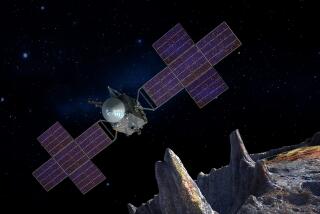Scientists Urge Search for Earth-Threatening Asteroids : Space: Conference seeks ways to improve detection, but no certain remedies are known to avert collision.
SAN JUAN CAPISTRANO — A couple of years ago, an asteroid large enough to wipe out the city of Los Angeles crossed the Earth’s path close enough to get a lot of people’s attention.
Despite the hundreds of telescopes that are turned toward the night sky on any given evening, no one saw the asteroid until it had passed within a mere 400,000 miles.
That really bothers a lot of people, including a small band of experts who have assumed the responsibility of warning the world about approaching doom.
About 200 scientists from around the world gathered here this week to discuss ways of improving the chances of detecting approaching asteroids in time to do something.
But it is not yet clear just what, exactly, they might be able to do.
It may well be that of all the hundreds of large asteroids that are believed to pass routinely near the Earth, none is on a collision course.
Still, Eugene Shoemaker of the U.S. Geological Survey told the conference, “It would be prudent to at least go and discover whether there is a threat at all.”
The meeting, sponsored by the Pasadena-based Planetary Society, the National Aeronautics and Space Administration and several other organizations, concluded yesterday at the San Juan Capistrano Research Institute.
History shows that small asteroids strike the Earth every few hundred years, but asteroids large enough to cause a global catastrophe strike only about once every 10 million years, Shoemaker said.
If a large asteroid turns out to be on a collision course, it probably would be detected soon enough to give the world several decades to prepare for its arrival. That could allow enough time to send rockets to rendezvous with the asteroid and push it into a safe orbit.
But what about a smaller asteroid that might not be detected until weeks or days before it would wipe out a city the size of Los Angeles?
Some have argued that it might be possible to intercept it and blow it up, but others contend that this would just result in a shower of smaller asteroids that would rain down terror over a wider area.
John Pike, director of the Space Policy Project for the Federation of American Scientists, told the scientists that they would have one recourse: Evacuation.
However, many believe that scientists would not be able to pinpoint the most likely impact area closely enough to aid a safe evacuation.
“We could come within a few tens of kilometers,” said Tom Gehrels of the University of Arizona, one of the leaders of the effort to improve detection.
Privately, some scientists say that if that is the best they can do, they will keep the discovery to themselves in hopes of avoiding public hysteria.
The handful of people involved in the active search for asteroids--consisting of only three teams in the United States--complained during the conference about the lack of a systematic, global effort to detect asteroids. That, coupled with the limitations of the equipment that is being used, could let an asteroid big enough to cause destruction over a large region easily escape detection, they said.
As proof of that, scientists noted that although the world has many large telescopes, most of the near-Earth asteroids that have been discovered have been found with a small, 18-inch telescope at the Mt. Palomar Observatory.
A telescope that size is not powerful enough to detect smaller asteroids until they are extremely close to the Earth.
Telescopes are programed to track stars as they move across the heavens. An asteroid traveling toward the Earth moves in a different direction than the stars, and thus appears as a short line in contrast to the points of light representing the stars.
The length of the line tells astronomers how fast the asteroid is traveling and how close it is to Earth. (The faster the speed, the closer it is.)
The brightness of the streak depends on the distance and size of the object, and for smaller asteroids, the streak is frequently so dim that it is virtually impossible to detect until the object is dangerously close to Earth.
Thus only larger telescopes with greater light-gathering capability can reveal small asteroids that are still large enough to create havoc on Earth.
However, large telescopes already are oversubscribed for research on other targets, such as quasars and galaxies on the edge of the universe.
A comprehensive program would cost a few million dollars a year, Gehrels said. That is a paltry sum in the world of space exploration today, but the scientists were warned by a key congressional aide this week that other commitments will make it extremely difficult to get enough funding to carry out their program.
Even with adequate funding, most scientists believe that it will take 10 to 20 years to compile an inventory of asteroids that could pose some danger to the Earth.






